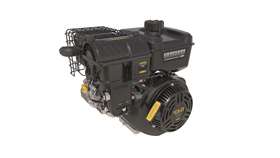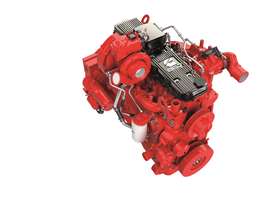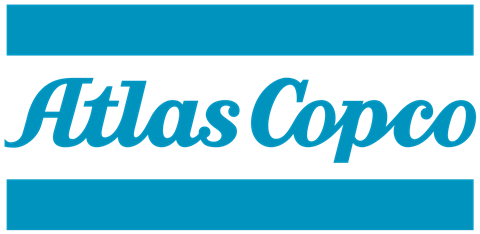Engines: Cutting emissions, not power
17 July 2019

For over a hundred years, research and development has been invested into internal combustion engines, cementing their position as the life blood of large machinery.
Despite the push for a new electric-powered market and hybrid engines coming onto the scene, it seems unlikely that diesel will be chiselled out of its spot as the number one engine power source for some time.
One company that firmly believes in diesel is Perkins, an engine manufacturer for nearly 90 years. In an interview with Construction Europe, Oliver Lythgoe of Perkin’s product concept marketing team, explained how EU emissions regulations have shaped the engines of today.
He said, “One perception is that all the investment has gone into emissions and it hasn’t really turned into customer value, but I don’t think that’s true because some of the things you do for emissions create a lot of customer benefits.
“When you have to make a much better fuel system, then you end up getting a more powerful new engine.” It is certainly true to say that engines have benefitted from becoming more fuel efficient and right now they are proving to be the most cost-effective method of powering a machine.
Engine Reliability and cost
It seems there is a consensus at Perkins that complete electric power is a long way off. Lythgoe said, “Fully electric is deeply problematic to do quickly because the batteries are extremely expensive. They are very big so they don’t fit in machines easily and in many cases there’s nowhere to recharge.”

When talking about the concept hybrids that the company unveiled at Bauma, he said it’s tempting to take that step, but there’s another, completely different path, which the company has also been experimenting with – using fuel sources that aren’t derived from fossil fuels. The idea is that these fuel types will then be able to run much in the same way as current diesel systems do, while recycling carbon molecules.
Yanmar is utilising gaseous fuel in some of its engines. The Japan-based company is developing gas-powered industrial engines that utilise LPG (liquid petroleum gas) and meet both EU Stage V and US EPA Tier2, and CARB Tier4 emissions regulations.
This technology is being utilised in two clean burning and quiet industrial engine models – the 4TN88G, with a maximum output of 45 kW, and the 4TN98G, with a maximum output 63 kW – now added to its lineup. Yanmar also has plans to introduce bi-fuel specification models that can run on both LPG and gasoline.

Gas engines produce very little particulate matter and are comparatively quieter than diesels. This makes them ideal for work indoors and in enclosed areas, where environmental concerns are a major consideration.
Yanmar has more than 30 years of experience working with gas engines and, according to the company, its proprietary engine control system optimises air intake to achieve even greater power and torque than its diesel engines.
Compact engine configuration
Yanmar has also created a compact air-fuel mixing system which it says results in an approximately 9% smaller engine. This is achieved by eliminating the conventional gas engines with mixer system. The company says that with this technology the engine layout is optimised to enable easy installation to forklifts, as well as construction and agricultural equipment.

German engineering company Man announced its new D4276 and D1556 engine series at this year’s Bauma trade fair in Munich. The company believes these additions put the firm in a better position to provide solutions for excavators, wheeled loaders, dumper trucks and mobile cranes.
Reiner Rößner, head of sales at Man Engines, said, “Engines for construction machinery are an important part of our long-established off-road business, which has deep roots at Man Engines. At the same time, we have invested many millions of euros in new and existing products in recent years.”
Man Engines has developed a complete selection of off-road products ranging from 4.6 litre to 24.2 litre displacement, based on the latest engine platforms and the newest technology. In terms of power, the new ranges will give OEMs a selection of seven engine series to choose from, spanning 118 kW to 816 kW. Early projects and collaborations confirm that the engines are also in demand and enjoying success in construction machinery.
Man has also been working on modular exhaust gas aftertreatment for EPA Tier 4 Final and EU Stage V regulations. This is important because current emission standards have a huge impact on equipment’s resale potential.
The integration of Man engines is possible with a high degree of packing density. There are 16 different modular exhaust gas aftertreatment (AGN) variants enabling machine manufacturers to make use of the space available within equipment, boosting compatibility and flexibility during engine installation.
Engine reliability for the rental market

Manufacturer of small single-cylinder engines Briggs & Stratton has announced that it has collaborated with European rental company Boels Rental to deliver user-driven innovation to the market. Following product trials with the new VanguardTM 200 single-cylinder engine, Boels indicated that it intends to utilise more Vanguard single-cylinder engines in equipment for its fleet.
Commenting on the collaboration, Paul Bramhall, senior marketing manager of Briggs and Stratton, said, “We are delighted to support Boels in offering their customers a better user experience, while promoting safety and sustainability benefits to the market.
“Vanguard engines are built to combine unmatched product performance with a lower Total Cost of Ownership. Our new generation of single-cylinder engines will be designed to set new performance standards in the industry. The new 200 engine, for example, delivers ease of starting down to -29°C, 40% lower noise, 15% less vibration and 50% less oil wastage.”
Guy Cremer, director of fleet operations for Boels, said, “The new generation of Vanguard single-cylinder engines offers many game-changing improvements. The engines allow us to cut our equipment service intervals almost by half and drop our oil waste and recycling, thus reducing the environmental impact of our fleet.”
Vanguard’s 200 and 400 single-cylinder engines are the first two models in an all-new single-cylinder horizontal shaft commercial engine line. The new range was said to be developed around key areas of performance, critical to improving overall productivity. These areas include starting, noise, maintenance intervals, service and support, as well as total cost of ownership.
Refreshing the line

The first of a planned refresh of the diesel engine product line from John Deere Power Systems (JDPS) is the new PowerTech 13.6 litre diesel engine.
John Deere designed its new diesel engine with a “start from scratch” approach. The first step was to evaluate customer needs and generate a list of design requirements to meet those objectives. This clean-sheet approach meant John Deere spent a significant amount of time upfront in the development process, which refined later iterations of the product.
The new 13.6 litre engine, composed of a 6-cylinder in-line design, will have outputs up to 510 kW variable speed. The engine also uses cooled exhaust gas recirculation (EGR) and an in-line Integrated emissions control system (IECS) that the company says is capable of meeting Final Tier 4 and Stage V emissions regulations. The IECS can be mounted either horizontally or vertically, allowing for packaging and integration flexibility.
Because the company started with a clean slate, it was able to incorporate the EGR system into the fundamental design of the engine — a substantial advantage in regard to integration and packaging. OEMs can also spend less time integrating the engine because the wiring harness is already included, reducing complexity. The engine includes a rear gear train, offering reduced noise and enhanced operational flexibility.

Total engine life cycle was another point of emphasis for the 13.6 litre engine. The company says reliability, durability, manufacturability and serviceability were essential elements from the start. In addition, machine integration was a top priority and, helping to achieve this, the engine is about 18% smaller than its predecessor and weighs around 10% less.
Additional importance was placed on cost and ease of maintenance — both of which were enhanced with improvements in service cost and intervals. This is partially due to integrating hydraulic lash adjusters into the 13.6 litre engine, enabling optimum valve train performance, less noise and lower wear, while eliminating valve lash maintenance.

Other unique design features of the engine include integrating engine control unit (ECU) — directly improving reliability and fuel efficiency, while reducing packaging requirements. The ECU, which is manufactured by John Deere Electronic Solutions, has advanced model-based controls that enhance transient control. The ECU also incorporates new controls, such as a boost control system and optional compression brake.
The new 13.6 L diesel engine from JDPS is set to begin production in 2020 at the John Deere Waterloo Engine Works factory.
Stage V ready engines
UK-manufacturer JCB has announced that it is now ready for the stage V emissions standard. JCB Power Systems has announced its strategy to meet the regulations for 2019 and 2020. The new standards for engines below 56 kW and above 130 kW came into force on January 1, 2019, but for engines in the 56-129 kW range the standards take effect a year later on January 1, 2020.
The company will use a combination of next generation particulate control technology, incorporating diesel oxidation catalysts (DOC), integrated diesel particulate filter (DPF) and selective catalytic reduction (SCR) in order to achieve the stage V standards.

JCB has introduced a compact 3.0-litre EU Stage V diesel engine to its mid-range machines. The four-cylinder DieselMAX engine, is 24% smaller and 30% lighter than JCB’s own 4.4-litre EcoMAX powerplant, yet offers 10% higher torque output, with a real world 5% fuel saving. The engine uses innovative particulate and NOx control technologies, that combine the DPF and DOC in a single unit. The engines feature autostop technology for further emissions reduction.
The 3 litre engine delivers 55 kW with 440 Nm of torque at just 1,150 rpm, 10% higher than the larger 4.4 L EcoMAX. The compact engine produces 5% less CO2 while benefitting from a 5% fuel consumption improvement.
Service and maintenance costs for this model have also been cut by 30% as a result of; 500-hour service intervals, hydraulic lash adjusters in the valve train and a sealed-for-life crank case ventilation module, eliminating filter replacement.
The engine is equipped with four glow plugs, for easier cold weather starting and reduced cranking time. A fully integrated JCB LiveLink telematics system is also equipped on the engine, providing operating information in real-time for customers and dealers.
The compact dimensions of the down-sized 3 litre engine, have allowed JCB’s engineers to install the engine and exhaust after-treatment within existing engine canopies to maintain market-leading visibility.
The 3 litre Stage V engine will be offered on the 531, 535 and 540 Loadall models, 3CX backhoe loaders, large platform skid steer and compact track loaders, 6T to 9T site dumpers, RTFLs and 13 tonne excavators.
Alan Tolley, JCB’s group director of engines, said, “JCB engines have low emission, high efficiency combustion technology developed for Stage IIIB and Tier 4, which means we started development for Stage V from a very good position.
“JCB’s particulate control technology features low particulate combustion, an oxidation catalyst, particulates filter and integrated engine and filter regeneration control system.
“It’s a completely integrated solution that’s highly reliable, highly effective and invisible to the customer as it is installed within our existing machines’ engine bays, and, in normal use, no operator intervention or additional service attention is required.”
Powerful engine performance

Caterpillar Energy Solutions has launched its new MWM TCG 3020 V20 gas generator set, offering more power and reduced oil consumption on its predecessor.
The generator is said to have an electrical efficiency of up to 45% and Caterpillar believe that this combination of efficiency, reliability and performance makes the TCG 3020 V20 an all-round talent among gas engines.
Though its dimensions are almost the same as those of its predecessor, the MWM TCG 3020 V20 gas engine boasts an output of 2,300 kW, a performance increase of up to 15%. Alongside reduced oil consumption of 0.15 g/kWh, the new model offers lower maintenance and installation costs.
The generator can be powered by natural gas, biogas, landfill gas and propane. The new MWM power genset enables an electrical efficiency of 45% for natural gas and 43.6% for biogas. The overall efficiency in natural gas operation is more than 87%. Provided high-quality gas is used, maintenance intervals of up to 80,000 operating hours are said to be possible before a general overhaul.
A digital control system known as Total Plant & Energy Management (TPEM) consolidates all genset and plant control data in a single system. TPEM facilitates the control and monitoring, not only of the power genset, but also of the entire distributed energy generation plant. In most application scenarios, this eliminates the need for additional control systems.
The manufacturer celebrated 100 years in the diesel engine industry at Bauma 2019.

When speaking to Steve Nendick, marketing communications director from engines manufacturer Cummins, about whether or not diesel would last another 100 years, he said, “Although we cannot see into the future, if we look ahead as far as 2119 it is not difficult to imagine a world where non-fossil fuel power is the norm, rather than the exception given the advances we have made already this century.
“However, right now and for the foreseeable future, the high-power density and machine capability required from heavy-duty construction equipment means ultra-clean diesel power is the most viable and proven power solution, particularly as Stage V regulations comply with even the strictest low emission zones.”
“Cummins’ strategy will always be to develop the most efficient powertrain solution for our customers and this is reflected by annual R&D investment of almost $1billion [€892 million] to ensure we can deliver the right power choice at the right time.”

Agco Power expanding
AGCO Power is expanding its main assembly facility in Finland.
To maintain cost effective production and to increase its capacity, the company is increasing the size of its production, warehouse and office area by an additional 10,000 m2.
The company also intends to expand its non-agriculture off highway diesel market offering with a standardised engine kit that will not require any installation work.
Along with the upscaling of the company’s current facility, the company is looking to improve its distribution channels and service. In this respect the company is investigating potential partners, particularly in Europe to become dealers.


Atlas Copco provides guidance for Stage V
Atlas Copco Power Technique has published a free e-guide that explains the impact of new European Commission emissions standards legislation on non-road machinery such as compressors, generators, pumps and light-towers.
The route to Stage V compliance and beyond outlines the scope of the Stage V standards, which are being implemented in 2019-2020 as a means of reducing air pollution. Stricter limits on emissions of particulate matter (PM) are being enforced, along with newly proposed particle number (PN) limits, forcing manufacturers to equip some non-road engines in certain power categories with equipment such as diesel particulate filters.
The e-guide provides customers with a clear roadmap to Stage V compliance, while explaining how the new standards will lead to a range of cleaner and better performing products that will be quieter, smaller, and more fuel efficient than ever before.
Andrew Walker, president of Atlas Copco’s Power Technique Business Area, said, “While some industrial suppliers have struggled to come to terms with the impact of new engine architectures on the products they offer, Atlas Copco has long since recognised that the introduction of Stage V presents real scope for technological advancement.
“Atlas Copco can provide customers with a clear pathway to compliancy, offering an unrivalled range of next-generation compressors, generators, pumps and light-towers that will offer better performance and value than ever before.”




